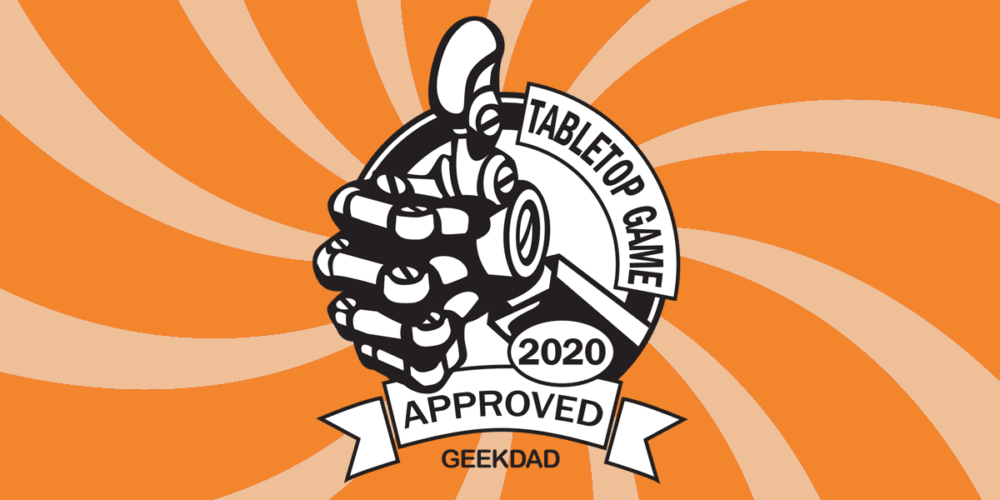Scientists believe there’s another planet out there in our solar system, but it can’t be detected directly. You must use your knowledge of other astronomical objects in The Search for Planet X.
The Search for Planet X was originally funded on Kickstarter in October 2019; GeekMom Sophie Brown wrote about the Kickstarter campaign. It has since been delivered to backers and is now available for purchase.
What Is The Search for Planet X?
The Search for Planet X is a deduction game for 1 to 4 players, ages 13 and up, and takes about 60–75 minutes to play. It retails for $40, and is available now in stores and directly from Renegade Games. The game is a deduction game that does have 4 levels of handicapping, so you can adjust the difficulty level for individual players. It is a bit more challenging than Clue, but I imagine that you could go below age 13 if your kids enjoy logic puzzles.
The Search for Planet X was designed by Ben Rosset and Matthew O’Malley and co-published by Renegade Games and Foxtrot Games, with artwork by Michael Pedro and James Masino.

The Search for Planet X Components
Note that in addition to the game components, you’ll need a device to run the free companion app (on iOS or Android). You can run the app on a single device or multiple devices, just depending on player preference.
Here’s what comes in the box:
- Solar System Board
- Earth board
- Sun disc
- 4 Player screens
- 48 Theory tokens (12 per player)
- 8 Target tokens (2 per player)
- 4 Telescope pawns
- 4 Expert panels
- Note sheet pad
You’ll also need to provide your own writing utensils.

The solar system board is double-sided for the standard and expert game. It shows a 360-degree view of the night sky, with the horizon (showing the four seasons) wrapping around the outside edge of the board. The Earth board is a disc that goes over the center and is held in place by the yellow wooden disc representing the sun: the Earth rotates around the sun, indicating the current season and also which half of the sky is currently visible.

The sectors are simply numbered wedges of the night sky (12 sectors for standard mode, 18 for expert mode), each showing a series of boxes where theory tokens will be placed and advanced along a track. The theory tokens are color coded per player; each one shows a “document” icon on one side, and then a specific object on the other side: asteroid, comet, and so on.
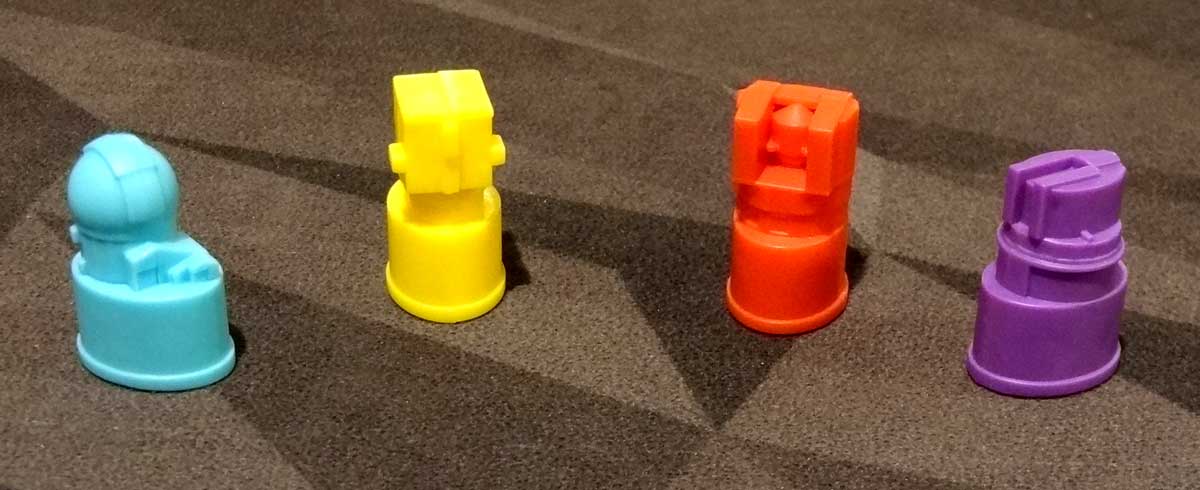
The player pawns are made to look like observatories, and each one is a unique shape, which is a nice touch. They’re modeled after actual observatories, as detailed inside the corresponding player screens.
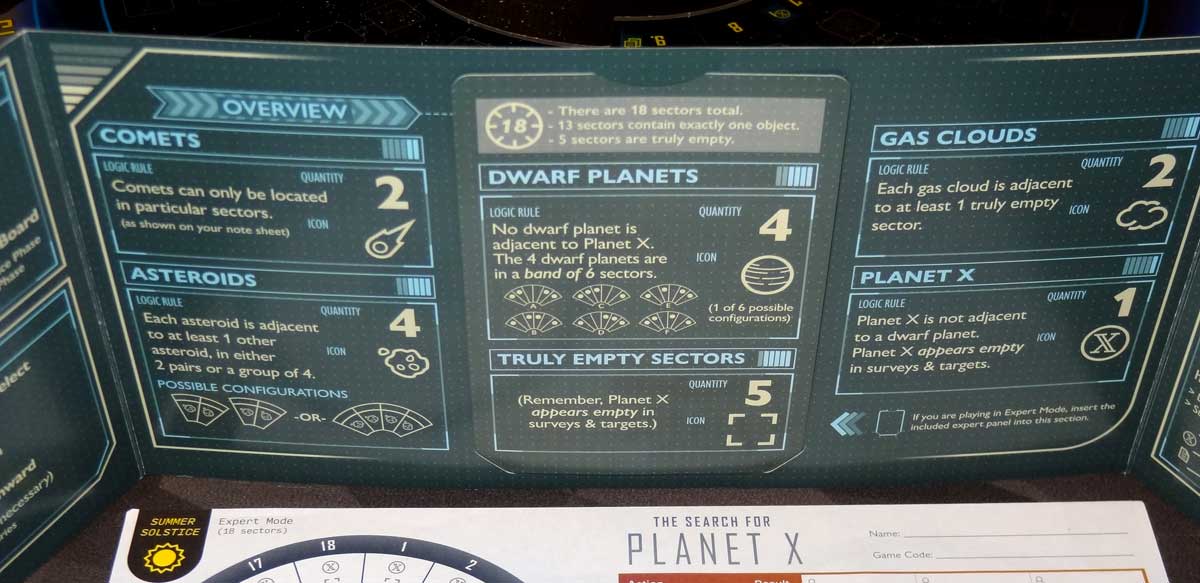
The player screens hide your note sheet from other players, but they also have a lot of information on the back, like the turn overview, rules about different objects, and game end scoring. The screens have some notches cut into them so that you can tuck the “expert panel” card into the center of the screen, replacing some of the information for the expert game. The fronts of the screens feature illustrations of the different observatories that the pawns are modeled on, another great detail.

The note sheet is where you’ll record your information and guesses. It’s a wide sheet that shows the circular night sky diagram on the left with all of the basic object rules below it; each wedge of the night sky shows all the possible objects in that sector. On the right side there’s a table for you to record the actions that you and your opponents take, as well as a section for research, and then a scoring row at the bottom. The sheets are double-sided, with standard mode on one side and expert mode on the other. One nice touch is that there are four versions of the sheets, corresponding to the four seasons, so that when you use the sheet corresponding to your side of the board, the sky diagram is oriented the same way, reducing the chance of rotation errors while you play.
The rulebook includes some sidebars about the science that inspired the game’s theme: hypotheses about the existence of a ninth planet, and what properties it may have.
How to Play The Search for Planet X
You can download a copy of the rulebook here.
The Goal
The goal of the game is to gain the most renown by submitting accurate theories about the locations of various objects—locating Planet X is worth a lot of points, but it’s not the only thing you’ll be searching for!
Each sector contains at most one object, and the number and type of objects will always be the same. Each object also has some logic rules (shown both on the note sheet and the player screens): for instance, dwarf planets will never appear next to Planet X, and every asteroid is next to at least one other asteroid. Planet X never shows up in your scanners, though, so its sector will appear as an empty sector.
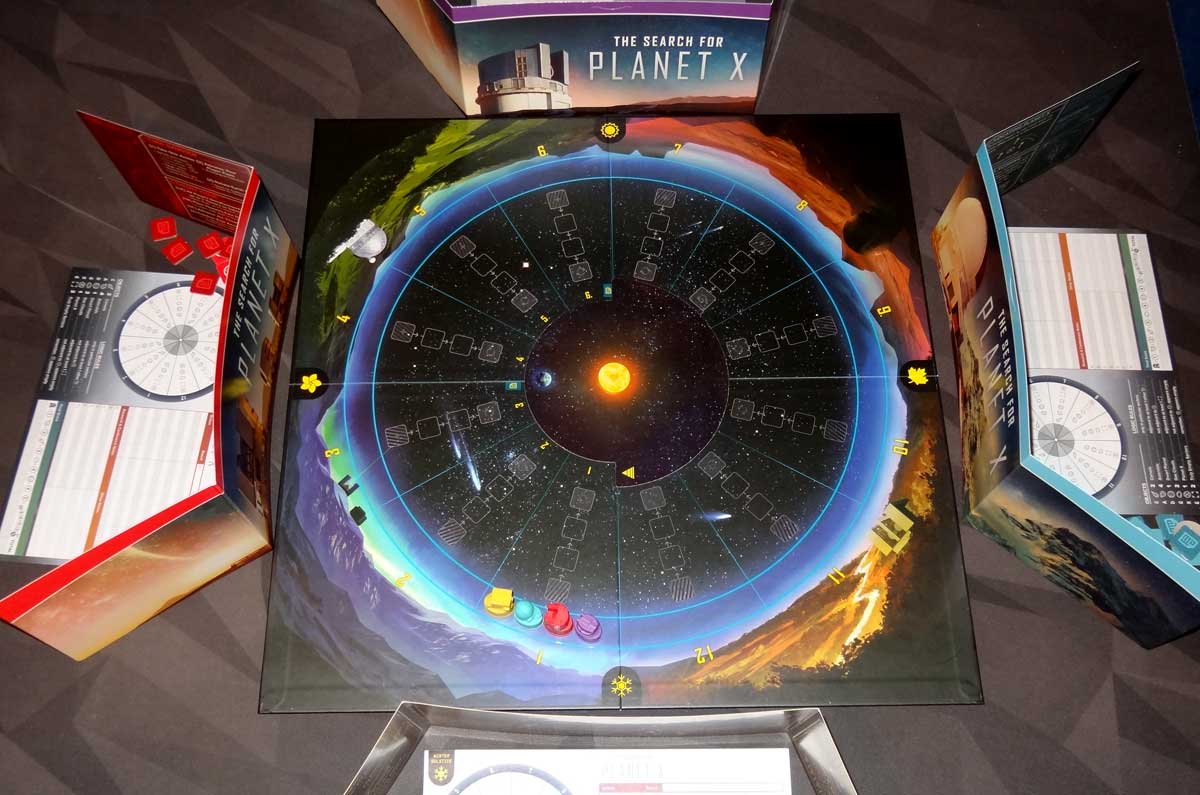
Setup
Place the board in the center of the play area, connecting the Earth board with the sun disc. Rotate it so that the arrow on the Earth board is pointing to sector 1. Give each player a player screen and the theory tokens in their color, 2 target tokens, and a note sheet corresponding to their side of the board. (If playing in expert mode, give each player the expert panel to add to their screen.) Place all the pawns on the outer rim of the board in sector 1, in random order.
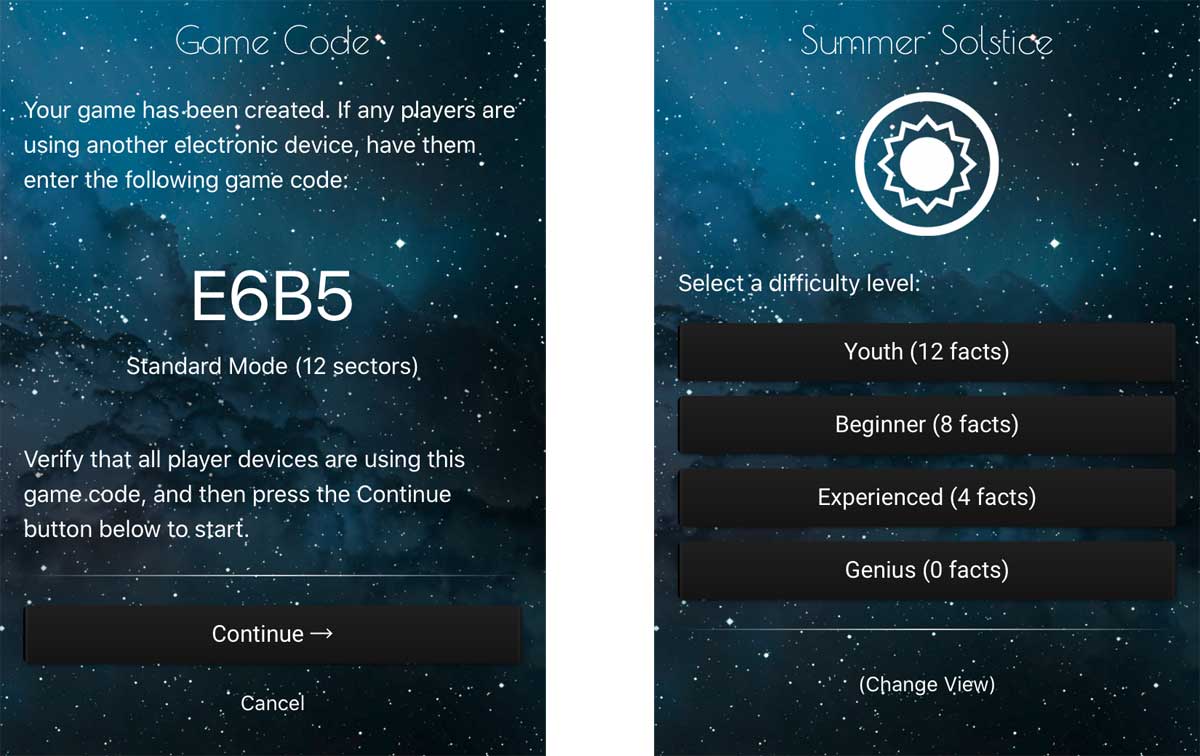
Start the app. If you’re using multiple devices, one player will start the game and the other players enter in the same game code, so that everyone is using the same location of objects. Each player can then select a difficulty level, from “Youth” to “Genius,” which determines how many facts they get to see before the game begins. For instance, you might be told that there are no asteroids in Sector 5. Everyone is provided with a random set of facts, so even if two players both choose “Beginner,” they may not have the same 8 facts. Everyone secretly records their starting facts on their note sheets.

Gameplay
In The Search for Planet X, players do not take turns in a clockwise order. Instead, the player whose pawn is furthest back on the time track (most counterclockwise) gets to go, spending time to take actions. If they’re still the furthest back, they continue taking turns until they are no longer in the back. When you enter the same space as another player, you place your pawn so that it is ahead of theirs, so they will take turns before you go again.
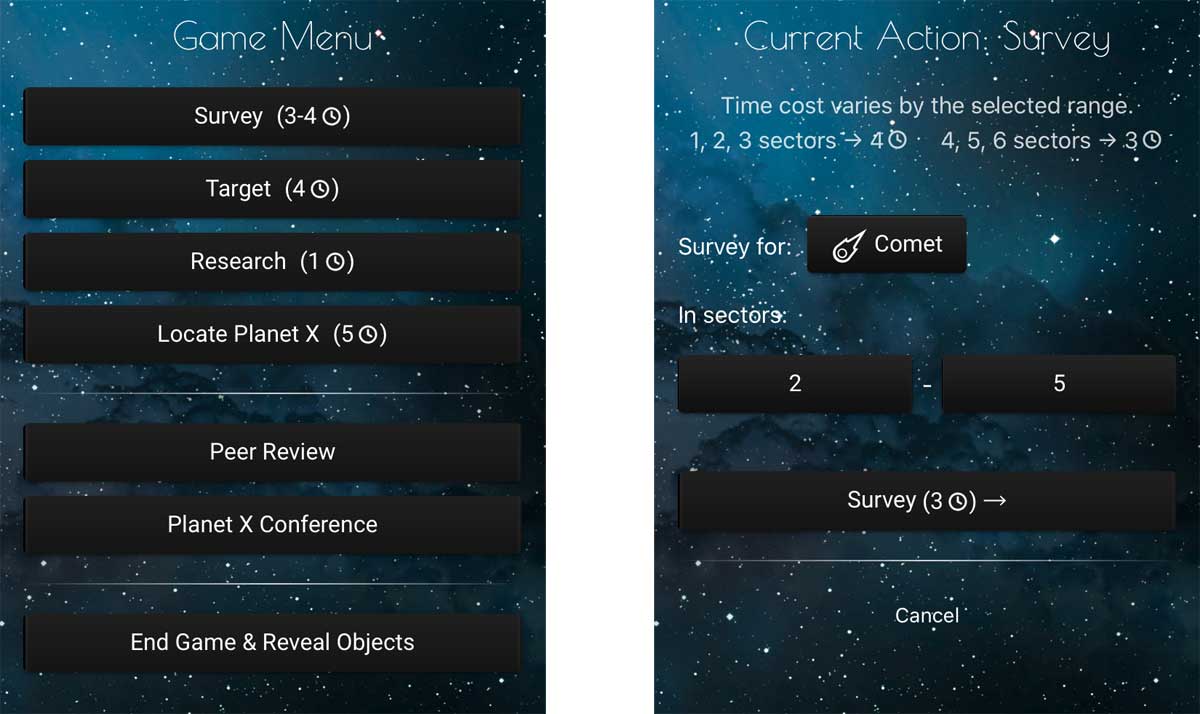
There are four actions you may take, each requiring a different amount of time:
- Survey for an object (2 to 4 time): Choose a specific object and range of sectors in the visible sky; the app will tell you how many of that object you find in that range. (The narrower your field, the more time it takes.)
- Target a sector (4 time): Choose a specific sector; the app will tell you exactly what is in that sector. You may only do this twice per game, spending your target token.
- Research a topic (1 time): Select one of the research topics that you haven’t studied before; the app will give you a new logic rule applying to that topic. You may not research twice in a row.
- Locate Planet X (5 time): Indicate which sector Planet X is in, and also identify what is in the two sectors adjacent to it. If you’re correct, you will score 10 points and trigger the end of the game.

After you take your turn and move your pawn, you rotate the Earth board clockwise if necessary—the arrow should always point at the sector where the furthest behind player is, and the section of visible sky will advance. Essentially, on your turn you will always be able to see half of the sky, starting from your current sector and going clockwise.
The first time the Earth board reaches or passes each conference icon, there’s a conference phase. (There is one in standard mode, and two in expert mode.) Press the “Planet X Conference” button in the app, and it will provide a new logic rule that everyone can record on their note sheet.
Each time the Earth board reaches a theory icon, you pause for a theory phase, where players may make guesses about which objects are in specific sectors.
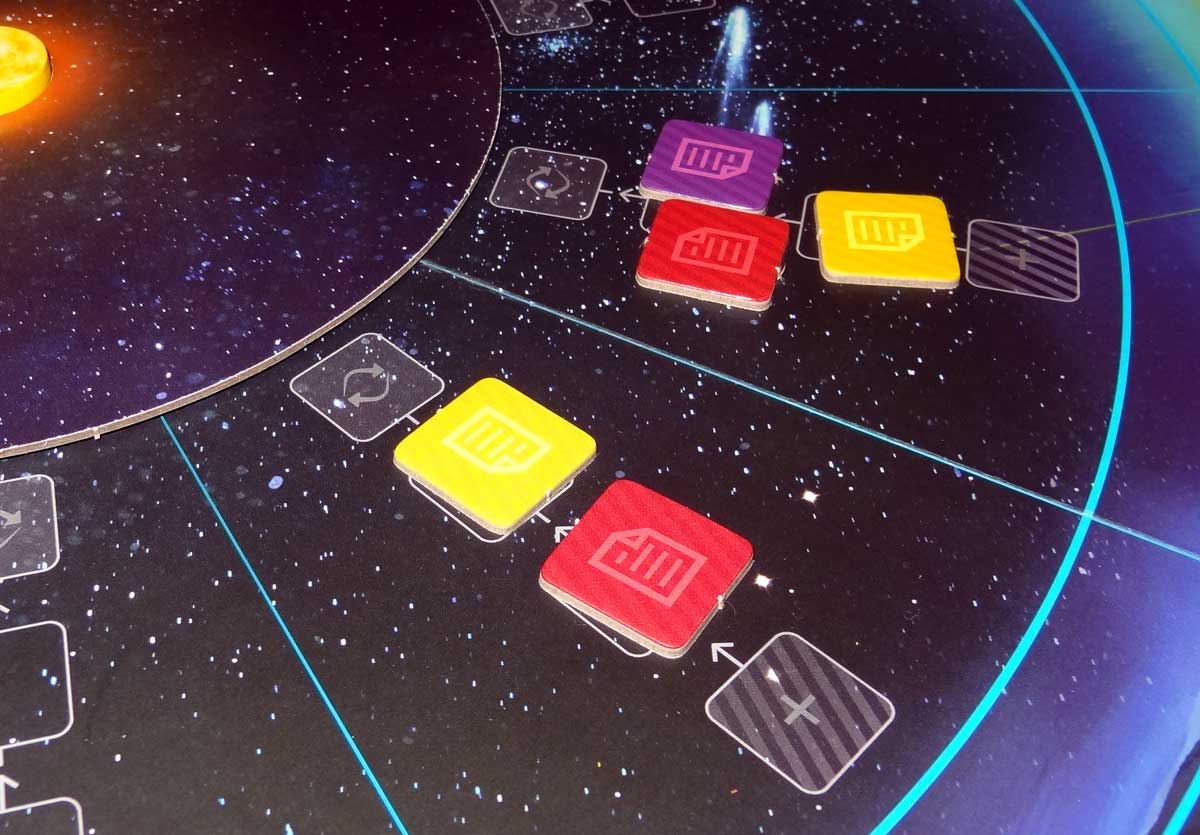
First, everyone simultaneously chooses theories they would like to submit, if any (up to 1 in standard mode, up to 2 in expert mode), covering those tokens with their hands. Everyone simultaneously reveals how many theories they want to submit but not what those theories are. In turn order according to the player pawns, each player then places their theory tokens face-down in the appropriate sectors on the outermost square of the track. You may submit theories for any sector, not just in the visible sky. More than one player may submit theories for the same sector—their theories are just stacked or placed side-by-side.
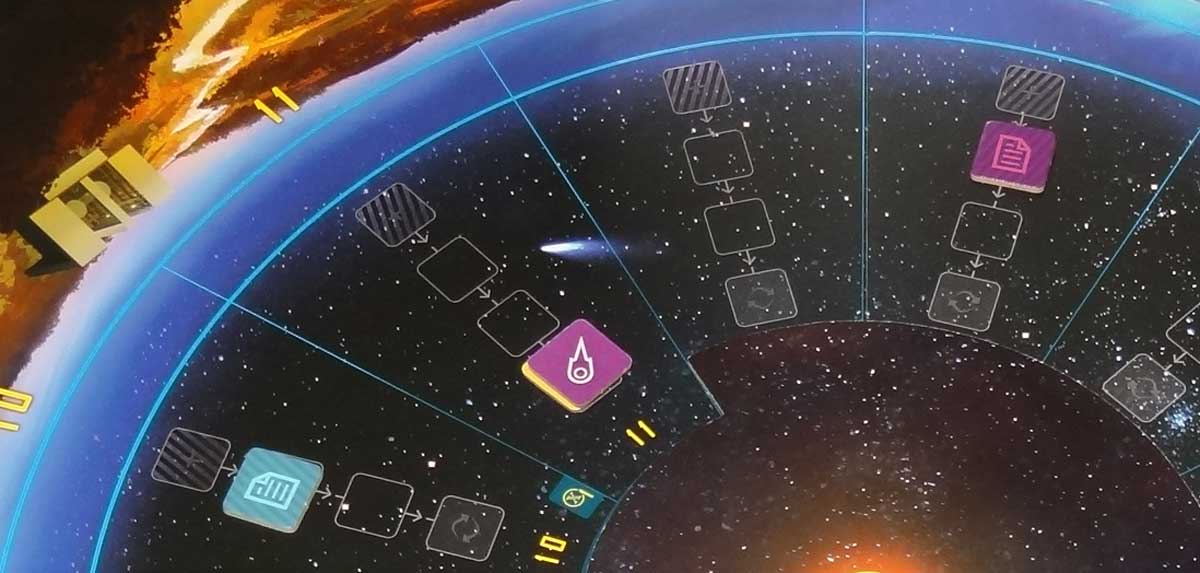
Then, all theories are advanced inward on the tracks. If any theories reach the last square, it is time for a peer review! Reveal the theories that have reached the last square, and use the “Peer Review” button in the app to check the results. If a theory is incorrect, the token is removed from the game (and everyone can cross out that object in that sector). If a theory is correct, then all of the theories in that sector are revealed—matching theories are left on the track, and incorrect theories are removed from the game. Once a theory has been confirmed to be correct, players may no longer submit theories for that sector.
Game End
If a player successfully locates Planet X (remember, you also have to correctly identify what is in the two adjacent sectors), then the game end is triggered. Any player who is further back on the board will get one more turn to score points: you may either submit theories or also try to locate Planet X. The number of theories (one or two) you may submit depends on how far back on the time track you are. If you attempt to locate Planet X, you will score points based on how far back you are.
After all other players have had their last turn, add up the scores:
- For each correct theory that you submitted first (or tied for first), you get 1 point as a leader bonus.
- You score for correct theories based on the object:
- Asteroids: 2 points
- Comets: 3 points
- Gas Clouds: 4 points
- Dwarf Planets: 4 points in standard mode, 2 points in expert mode
- You score points if you correctly located Planet X: 10 points if you were first, and 2 to 10 points otherwise, based on your location.
The highest total score wins; ties go to the player who scored the most points for Planet X, then the most points for leader bonuses.
Solo Game
The solo mode was added later, and requires a separate rulebook available for download. The latest version of the app includes a “Solo Game” option at the bottom of the screen. You’ll set up for a 2-player game, with a second color representing the bot. As the bot takes its turns, you can record its actions the same way you would with a human opponent. The bot may also submit theories, but it only submits theories that it knows are correct. (You’ll use one color face-down for submitted theories, and another color face-up for confirmed theories, since the app won’t tell you what theory was submitted ahead of time.) You compete against the bot for scoring.
The Search for Planet X is GeekDad Approved!
Why You Should Play The Search for Planet X
I’ve always enjoyed deduction games like Clue, where you accumulate information, eliminate possibilities, and figure out the answer. The Search for Planet X uses logic rules instead of a simple process of elimination, which makes it a really engaging puzzle. In Clue, you just have to figure out what’s in the envelope: if you see the candlestick card, then you can safely eliminate it as the murder weapon. But here, you have to see how the various rules fit together to determine what is in each sector. It’s all about the relationships between the objects.
You start off with a set of rules about the objects that is always the same from game to game. Comets can only appear in particular sectors (as indicated on the note sheet). Gas clouds are always next to a truly empty sector. Depending on your difficulty level, you’ll also get a few hints—usually not enough to pinpoint a specific object yet, but perhaps enough to point you in a particular direction at first.
Research can be very valuable, because it gives you additional logic rules, and you know what objects will be involved so you can choose the right research topic. If you’ve already identified the comets, maybe you want to research the “comets and gas cloud” clue. You’ll get rules like “every asteroid is within 3 sectors of a comet” or “the dwarf planet is opposite an asteroid.” Sometimes you might get a rule that you’ve already figured out yourself, but ideally you’ll get some new information that lets you cross off a few more objects here and there.

Aside from the deduction aspect, you’ll also need to pay attention to how you use your time and which actions you take. Research only spends 1 time, but you can’t do it twice in a row. Targeting a sector gives you the answer right away—but it uses 4 time, and you can only do it twice per game. The bulk of your actions will probably be surveying: choosing an object and a range of sectors. Thematically, it seems a little counterintuitive that scanning a larger area of sky takes less time than scanning a smaller area, but for the game it makes sense: the more definitive your answer, the more time it takes. It takes less time to survey “how many asteroids are in sectors 3–8?” than “how many asteroids are in sector 3?” For the first question, if you find there are 2 asteroids, they could be anywhere in that range. For the second question, you’ll know exactly whether or not there’s an asteroid in sector 3.
The reason this matters, of course, is because it’s a race. As with games like Tokaido, if you jump ahead because you spent a lot of time on an action, you’ll be waiting for everyone else to catch up to you before you get another turn—though whether they’re able to get more information with shorter actions could be a toss-up. The other reason it matters is because you can only survey or target visible sectors, so as you move around the board, you only have access to half the sky. There have been plenty of times where I looked down at my sheet and realized that I’d already figured out everything about the section of sky I could see, and I just had to kill some time to get back around to the other side of the board before I got new information. Timing can be crucial.
I really love the theme of the game, too. Sure, the mechanics don’t entirely line up with the theme, as I’ve mentioned already. We don’t expect that objects in the sky are evenly distributed or that they follow logical rules. But I appreciate that we’re doing research, scanning the skies, and submitting theories that get “peer reviewed” before we can publish them. I also like the idea of the Planet X conferences—that moment where we all got together and listened to a talk, coming away with some new information that (usually) none of us had come up with ourselves.

The fact that the game is app-driven is both a plus and a minus. On the plus side, the game can come up with a countless number of possibilities for the placements of the objects, as well as all of the different rules that you’ll get from research and the conference. Using the game codes, I was able to play with some friends remotely—they had their own note sheets and ran the app, and then looked at my board through videochat, and it worked pretty well because the most important information you need is all on your note sheet. On the downside, there is no way to play the game without the app. While you could theoretically have one person play the role of the app, putting the objects into place and answering questions for the other players, coming up with the logic rules for the research and conference would be quite difficult. Plus, if they made just one logic mistake while placing the objects, the whole thing could fall apart. For games that use apps, there’s always a question of longevity—how long will the app be supported? What happens when devices get OS updates? My recommendation is: enjoy the game now, because you don’t know for sure if it will still work in 5 or 10 years.
I’ve gotten to play The Search for Planet X several times during quarantine, and have enjoyed it every time. I’ve experimented with the different difficulty levels (including the “Genius” level that gives you no starting information), though I haven’t yet played on the expert board. My middle daughter (age 13 at the time) really enjoyed it too, and it was great being able to have players start at different difficulty levels based on their experience with the game or comfort level with deduction.
If you like the astronomy theme, or especially if you enjoy deduction games, I highly recommend The Search for Planet X.
Find out more on the Foxtrot Games website!
Click here to see all our tabletop game reviews.
![]() To subscribe to GeekDad’s tabletop gaming coverage, please copy this link and add it to your RSS reader.
To subscribe to GeekDad’s tabletop gaming coverage, please copy this link and add it to your RSS reader.
Disclosure: GeekDad received a copy of this game for review purposes.

